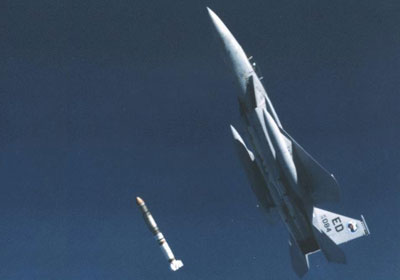Letter: Regarding “sticky airbags”by Dwayne A. Day
|
| There has long been a substantial gulf between the hawkish pro-space weaponization crowd and the actual civilian and military operators who have to build, fly, and make policy for military space systems. |
The article also states that if orbital debris “was as dangerous as has been claimed, spacecraft would be breaking up on an almost weekly basis.” But like the refusal to name who is being “naïve and self-delusional” about space weaponization, the article also does not indicate who is making such supposedly extreme claims. Nor does it acknowledge that several satellites are known to have been hit by debris and taken out of operation. Later the article states “Whatever happens the US should be wary of making too big a deal out of the orbital debris issue.” What these statements clearly miss is the fact that the United States already makes a “big deal” out of the orbital debris issue, and with good reason. Rather than some vaguely defined whining liberal environmentalist whacko anti-space weaponization crowd, the biggest push for orbital debris prevention has been the United States government, including the military.
For instance, Defense News reported on a March 2001 Defense Writers Group meeting where then-commander of Space Command General Ralph Eberhart explained that “if the United States starts ‘blowing up things in space’ the collateral damage may be too high… For example, while trying to take out an enemy satellite capability, a KE-ASAT could inflict damage on U.S. satellites or other commercial satellites, he explained.” Eberhart also “said he would rather employ satellite disruption tactics that are ‘temporary and reversible as opposed to blowing it up.’”
NASA also has an orbital debris office, which states:
Controlling the growth of the orbital debris population is a high priority for NASA, the United States, and the major space-faring nations of the world to preserve near-Earth space for future generations. Mitigation measures can take the form of curtailing or preventing the creation of new debris, designing satellites to withstand impacts by small debris, and implementing operational procedures ranging from utilizing orbital regimes with less debris, adopting specific spacecraft attitudes, and even maneuvering to avoid collisions with debris.
The NASA site also explains that:
In 1995 NASA was the first space agency in the world to issue a comprehensive set of orbital debris mitigation guidelines. Two years later, the U.S. Government developed a set of Orbital Debris Mitigation Standard Practices, based on the NASA guidelines. Other countries and organizations, including Japan, France, Russia, and the European Space Agency (ESA), have followed suit with their own orbital debris mitigation guidelines. In 2002 after a multi-year effort, the Inter-Agency Space Debris Coordination Committee (IADC), comprised of the space agencies of 10 countries as well as ESA, adopted a consensus set of guidelines designed to mitigate the growth of the orbital debris population. These guidelines were formally presented to the Scientific and Technical Subcommittee of the United Nations Committee on the Peaceful Uses of Outer Space in February 2003.
Debris mitigation is also part of the official national space policy adopted last summer. The reason is simple: with the most satellites, as well as astronauts in low Earth orbit, the United States has the most to lose from greater orbital debris, no matter how it is produced.
Thus, rather than a struggle between “America’s space warriors” versus a strawman group of anti-space weaponization hysterics concerned over an overblown orbital debris threat, it is the US government that has raised the issue of orbital debris the most, and adopted practices intended to reduce debris. It is also the US government that has led the way in international forums on this issue, adopting guidelines and negotiating in the United Nations. This concern with debris prevention has also long been a priority for American ASAT weaponry.
Finally, it is worth repeating that the US government that has not yet seen a compelling need for an ASAT capability. Whether or not the United States requires anti-satellite weapons is a debate that has not been settled, but it is clear that minimizing debris will be a major part of that discussion.
